This early edition of In The Greenhouse brings some interesting hybrids and species. All plants mentioned are from the New World, with the exception of the Dendrobium hybrids, which originate in Southeast Asia and Northern Australia. With the continued rain all through the cooler days, snails have been an incredible problem and several Phalaenopsis and Miltonidium flower spikes have been lost to snail damage. Slimy bastards.
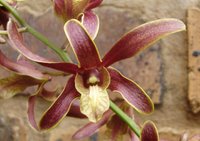 Dendrobium King Cobra. This relatively new addition to the collection has curiously twisted copper flowers on a nice upright inflorescence.
Dendrobium King Cobra. This relatively new addition to the collection has curiously twisted copper flowers on a nice upright inflorescence.
 Laelia anceps. This Mexican species is renowned for being easy to grow and flower. Apparently, it is often found growing in coffee plantations. Always a winner, it's been used in too many hybrids to list, mostly for its open flower shape, intense colour and incredibly long flower spikes.
Laelia anceps. This Mexican species is renowned for being easy to grow and flower. Apparently, it is often found growing in coffee plantations. Always a winner, it's been used in too many hybrids to list, mostly for its open flower shape, intense colour and incredibly long flower spikes.
 Masdevallia Copper Angel 'Highlands'. Masdevallia is one of my favourite genera. Miniature plants carrying enormous, triangular flowers with luminous colours - how can you not fall in love? They like coolness and high humidity, since they grow in the cloud forests of the Andes, where temperatures are never extreme and moisture drips from every surface. This exquisite hybrid is floriferous with open flowers carried singly on long inflorescences. The brightly coloured parts you see are actually fused sepals, the petals and lip being the much reduced structures in the centre of the flower.
Masdevallia Copper Angel 'Highlands'. Masdevallia is one of my favourite genera. Miniature plants carrying enormous, triangular flowers with luminous colours - how can you not fall in love? They like coolness and high humidity, since they grow in the cloud forests of the Andes, where temperatures are never extreme and moisture drips from every surface. This exquisite hybrid is floriferous with open flowers carried singly on long inflorescences. The brightly coloured parts you see are actually fused sepals, the petals and lip being the much reduced structures in the centre of the flower.
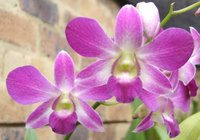 Dendrobium Nehama ben Juda. I'm not too sure about the name of this plant. The tag is quite legible, but this grex is not registered on Sanders' List. I've seen Thai hybrids that look identical, however, which were called Den. Pramote. This is a strong grower with tall canes to support the starry flowers, no matter what it's actually called.
Dendrobium Nehama ben Juda. I'm not too sure about the name of this plant. The tag is quite legible, but this grex is not registered on Sanders' List. I've seen Thai hybrids that look identical, however, which were called Den. Pramote. This is a strong grower with tall canes to support the starry flowers, no matter what it's actually called.
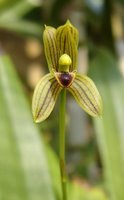 Mormolyca ringens. The name means 'hobgoblin' and I purchased this plant from the lovely people at Afri-Orchids last year. It has wonderfully round pseudobulbs and miniature greenish flowers (the one in the photo is only about 10mm in height). It is cultivated under shade net on the west side of the house and is watered twice a week; a regular wet-dry cycle seems to suit this orchid.
Mormolyca ringens. The name means 'hobgoblin' and I purchased this plant from the lovely people at Afri-Orchids last year. It has wonderfully round pseudobulbs and miniature greenish flowers (the one in the photo is only about 10mm in height). It is cultivated under shade net on the west side of the house and is watered twice a week; a regular wet-dry cycle seems to suit this orchid.
 Dendrobium Miss Singapore. A very famous hardcane dendrobe produced by the thousands for the cut flower market. It has superior colouring and the preferred full round shape. It often reflowers from the older canes.
Dendrobium Miss Singapore. A very famous hardcane dendrobe produced by the thousands for the cut flower market. It has superior colouring and the preferred full round shape. It often reflowers from the older canes.
 Miltonia Golden Jaguar. This was received as a division from a friend, and what a royal gift it is. The long lasting blooms have distinct barring, giving it aptly feline features. The combination of golden yellow with the red-blotched purple lip is unusual adding to its appeal.
Miltonia Golden Jaguar. This was received as a division from a friend, and what a royal gift it is. The long lasting blooms have distinct barring, giving it aptly feline features. The combination of golden yellow with the red-blotched purple lip is unusual adding to its appeal.
 An intense week has gone by. I'm trying to sort out my life, trying to find time, drowning in it all. I've had to schedule my TOEFL test, which took 11 days to do. Why is the ETS office for all of Africa in the Netherlands? I sent them a fax: then waited. I sent them an email: waited some more. Got some so-called automated responses back. Tried to register online, which failed. Finally they replied to tell me that the test centre in Johannesburg only offers the internet based test, not the computer based test (which is what my registration form was for). I was informed that I had to resend my info, which makes no sense. Surely it's just one office? Surely both kinds of test require some ability to read off a computer screen and type things on a keyboard? By some miracle, I managed to register online later that afternoon. Now I have to wait for the 28th of April, which is the earliest date I could register for. All of this to prove to the people at Colorado State University that I comprehend English. I watch South Park. My speaking English won't help. I'm also trying to finish up some research posters for the SAGS conference in Bloemfontein and something called the IPRI conference in West Lafayette, Indiana. Luckily, I'm going to neither, as I have plans for the beginning of April. The posters will be presented on my behalf by other people. Being the control freak that I am, I'm trying to make them really comprehensive, as I have no real idea of what's supposed to be on them, or of what'll happen to them once they leave my hands. So little sleep. So very little sleep.On the 3rd of April, two days after I turn 25, I will witness Depeche Mode in concert at Wembley Arena. I 'discovered' dM in 1995, the year after their record-breaking 7 dates at the Standard Bank Arena in Johannesburg. But a year too late, nevertheless. For the past ten years I have spent more money on my passion for this band's music than on anything else and longed for the day when I, too, may hear them perform live as so many countless Northern Hemisphere fans have done. Now it's all actually happening and the nervous tension makes it very difficult to concentrate on work. I'm paranoid that something's going to go wrong, that the universe won't allow me to have this one moment, this thing that I desire so badly above all other things. It'll be the second time in my life that I travel abroad and the second time in a year, at that. Who doesn't become addicted to travelling, once they've tasted it? The world is so full of amazing stuff, and it's all disappearing so fast. I feel a compulsion to hurry, hurry, hurry. Madagascar, before it burns down; New York, before it becomes too expensive; Ecuador before it gets turned into a golf course; Mexico, before I'm too old. Too old, like my father...now. The photo accompanying this post is one my father took in November 1965, on a trip to Namibia, when he just started out. If you look closely, you can see Coke bottles and a box of Ouma rusks on the bonnet of the car. It was an escape, away from work and people, away from his so-called family, away from the orphanages in Pietermaritzburg, East London and Johannesburg where he grew up. The Namib is timeless and forgiving and will swallow anything, given enough time. It's a place where you can become more of yourself. Although my father doesn't talk about himself much, I know that this trip was a defining moment for him. And then he met my mother - his family - and came home to stay.
An intense week has gone by. I'm trying to sort out my life, trying to find time, drowning in it all. I've had to schedule my TOEFL test, which took 11 days to do. Why is the ETS office for all of Africa in the Netherlands? I sent them a fax: then waited. I sent them an email: waited some more. Got some so-called automated responses back. Tried to register online, which failed. Finally they replied to tell me that the test centre in Johannesburg only offers the internet based test, not the computer based test (which is what my registration form was for). I was informed that I had to resend my info, which makes no sense. Surely it's just one office? Surely both kinds of test require some ability to read off a computer screen and type things on a keyboard? By some miracle, I managed to register online later that afternoon. Now I have to wait for the 28th of April, which is the earliest date I could register for. All of this to prove to the people at Colorado State University that I comprehend English. I watch South Park. My speaking English won't help. I'm also trying to finish up some research posters for the SAGS conference in Bloemfontein and something called the IPRI conference in West Lafayette, Indiana. Luckily, I'm going to neither, as I have plans for the beginning of April. The posters will be presented on my behalf by other people. Being the control freak that I am, I'm trying to make them really comprehensive, as I have no real idea of what's supposed to be on them, or of what'll happen to them once they leave my hands. So little sleep. So very little sleep.On the 3rd of April, two days after I turn 25, I will witness Depeche Mode in concert at Wembley Arena. I 'discovered' dM in 1995, the year after their record-breaking 7 dates at the Standard Bank Arena in Johannesburg. But a year too late, nevertheless. For the past ten years I have spent more money on my passion for this band's music than on anything else and longed for the day when I, too, may hear them perform live as so many countless Northern Hemisphere fans have done. Now it's all actually happening and the nervous tension makes it very difficult to concentrate on work. I'm paranoid that something's going to go wrong, that the universe won't allow me to have this one moment, this thing that I desire so badly above all other things. It'll be the second time in my life that I travel abroad and the second time in a year, at that. Who doesn't become addicted to travelling, once they've tasted it? The world is so full of amazing stuff, and it's all disappearing so fast. I feel a compulsion to hurry, hurry, hurry. Madagascar, before it burns down; New York, before it becomes too expensive; Ecuador before it gets turned into a golf course; Mexico, before I'm too old. Too old, like my father...now. The photo accompanying this post is one my father took in November 1965, on a trip to Namibia, when he just started out. If you look closely, you can see Coke bottles and a box of Ouma rusks on the bonnet of the car. It was an escape, away from work and people, away from his so-called family, away from the orphanages in Pietermaritzburg, East London and Johannesburg where he grew up. The Namib is timeless and forgiving and will swallow anything, given enough time. It's a place where you can become more of yourself. Although my father doesn't talk about himself much, I know that this trip was a defining moment for him. And then he met my mother - his family - and came home to stay.
This is the month for hardcane dendrobes and a very pink month it is, too. The rainy season is not over yet, and the danger of flowers aborting and new growths rotting during dull days remains a concern. I have noticed some cymbidiums already pushing up their primeval-looking flower spikes out of the bark in their pots. Maybe a bit early, but the coolish weather must certainly be to blame.
 Dendrobium bigibbum var. compactum. This plant is an amazingly rewarding one to grow. Compact, as the name suggests, and exploding with magenta flowers with iridescent lips. Quite inviting. My specimen actually fell off its perch on the staging in my greenhouse, top heavy with all the blooms facing towards the light. Even after such a shock, none of the flowers were lost and it is quite a display in the living room.
Dendrobium bigibbum var. compactum. This plant is an amazingly rewarding one to grow. Compact, as the name suggests, and exploding with magenta flowers with iridescent lips. Quite inviting. My specimen actually fell off its perch on the staging in my greenhouse, top heavy with all the blooms facing towards the light. Even after such a shock, none of the flowers were lost and it is quite a display in the living room.
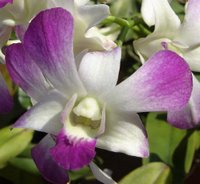 Dendrobium Pramote Mutation. That's the name on the tag, anyway. I can't really tell whether it is meant to read Promote Mutation, or whether it is some sort of reference to the Motes nursery (which I doubt). Illegible tags and nameless plants are always a nuisance; no matter how beautiful they are, some of the romance is lost to me.
Dendrobium Pramote Mutation. That's the name on the tag, anyway. I can't really tell whether it is meant to read Promote Mutation, or whether it is some sort of reference to the Motes nursery (which I doubt). Illegible tags and nameless plants are always a nuisance; no matter how beautiful they are, some of the romance is lost to me.
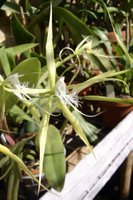 Epidendrum ciliare. According to the literature, the plants are often mistaken for white-flowering cattleyas when out of bloom. This is an awesome epi to grow, with enormous, spidery green flowers with complicated artifacts on the labellum. I love it. Snails love it, too.
Epidendrum ciliare. According to the literature, the plants are often mistaken for white-flowering cattleyas when out of bloom. This is an awesome epi to grow, with enormous, spidery green flowers with complicated artifacts on the labellum. I love it. Snails love it, too.
 Dendrobium (Midnight Velvet x Lipstick). An orchid straight out of a Thai bordello. Intense colour, large flowers and impressive flower count, this is a cross with lots of charisma. I have seen some of the other... uhm, "litter mates" from this grex and there is some variation in the fullness of the flowers as well as the intensity of the red pigment. The one pictured here is definitely awardable, if you ask me.
Dendrobium (Midnight Velvet x Lipstick). An orchid straight out of a Thai bordello. Intense colour, large flowers and impressive flower count, this is a cross with lots of charisma. I have seen some of the other... uhm, "litter mates" from this grex and there is some variation in the fullness of the flowers as well as the intensity of the red pigment. The one pictured here is definitely awardable, if you ask me.
 Pescatorea wallisii. A breathtaking species from an underrated genus in the Zygopetalinae tribe. This leafy plant comes from cloud forest in western Ecuador, doesn't have any pseudobulbs and produces fragrant flowers carried singly on inflorescences emerging from the newest mature growth.
Pescatorea wallisii. A breathtaking species from an underrated genus in the Zygopetalinae tribe. This leafy plant comes from cloud forest in western Ecuador, doesn't have any pseudobulbs and produces fragrant flowers carried singly on inflorescences emerging from the newest mature growth.
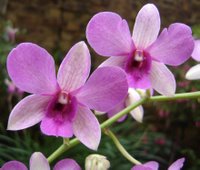 Dendrobium Genting Pink. Another case of mistrusting name tags from Asian nurseries. I always assumed Genting was Engrish for the dye gentian (I also have a plant called Den. Genting Blue), until I discovered that Genting is a city in Malaysia!
Dendrobium Genting Pink. Another case of mistrusting name tags from Asian nurseries. I always assumed Genting was Engrish for the dye gentian (I also have a plant called Den. Genting Blue), until I discovered that Genting is a city in Malaysia!
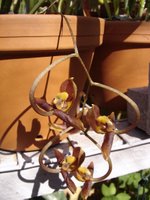 Gongora galeata. A delightful Mexican species with curiously twisted flowers emerging from a pendant inflorescence. The plant is related to Stanhopea and its rich brown insectoid flowers make for an interesting sight hanging below its ribbed pseudobulbs. Isn't nature just so weird and wonderful?
Gongora galeata. A delightful Mexican species with curiously twisted flowers emerging from a pendant inflorescence. The plant is related to Stanhopea and its rich brown insectoid flowers make for an interesting sight hanging below its ribbed pseudobulbs. Isn't nature just so weird and wonderful?
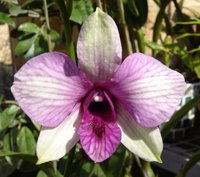 Dendrobium Pak Bung. I received this plant as a hand-me-down from a friend. It subsequently produced a number of large flowers with pink candy stripes on a light green background. A hypnotic hybrid with a bold labellum, I dare you not to like it.
Dendrobium Pak Bung. I received this plant as a hand-me-down from a friend. It subsequently produced a number of large flowers with pink candy stripes on a light green background. A hypnotic hybrid with a bold labellum, I dare you not to like it.
 Dendrobium King Cobra. This relatively new addition to the collection has curiously twisted copper flowers on a nice upright inflorescence.
Dendrobium King Cobra. This relatively new addition to the collection has curiously twisted copper flowers on a nice upright inflorescence.  Laelia anceps. This Mexican species is renowned for being easy to grow and flower. Apparently, it is often found growing in coffee plantations. Always a winner, it's been used in too many hybrids to list, mostly for its open flower shape, intense colour and incredibly long flower spikes.
Laelia anceps. This Mexican species is renowned for being easy to grow and flower. Apparently, it is often found growing in coffee plantations. Always a winner, it's been used in too many hybrids to list, mostly for its open flower shape, intense colour and incredibly long flower spikes. Masdevallia Copper Angel 'Highlands'. Masdevallia is one of my favourite genera. Miniature plants carrying enormous, triangular flowers with luminous colours - how can you not fall in love? They like coolness and high humidity, since they grow in the cloud forests of the Andes, where temperatures are never extreme and moisture drips from every surface. This exquisite hybrid is floriferous with open flowers carried singly on long inflorescences. The brightly coloured parts you see are actually fused sepals, the petals and lip being the much reduced structures in the centre of the flower.
Masdevallia Copper Angel 'Highlands'. Masdevallia is one of my favourite genera. Miniature plants carrying enormous, triangular flowers with luminous colours - how can you not fall in love? They like coolness and high humidity, since they grow in the cloud forests of the Andes, where temperatures are never extreme and moisture drips from every surface. This exquisite hybrid is floriferous with open flowers carried singly on long inflorescences. The brightly coloured parts you see are actually fused sepals, the petals and lip being the much reduced structures in the centre of the flower. Dendrobium Nehama ben Juda. I'm not too sure about the name of this plant. The tag is quite legible, but this grex is not registered on Sanders' List. I've seen Thai hybrids that look identical, however, which were called Den. Pramote. This is a strong grower with tall canes to support the starry flowers, no matter what it's actually called.
Dendrobium Nehama ben Juda. I'm not too sure about the name of this plant. The tag is quite legible, but this grex is not registered on Sanders' List. I've seen Thai hybrids that look identical, however, which were called Den. Pramote. This is a strong grower with tall canes to support the starry flowers, no matter what it's actually called. Mormolyca ringens. The name means 'hobgoblin' and I purchased this plant from the lovely people at Afri-Orchids last year. It has wonderfully round pseudobulbs and miniature greenish flowers (the one in the photo is only about 10mm in height). It is cultivated under shade net on the west side of the house and is watered twice a week; a regular wet-dry cycle seems to suit this orchid.
Mormolyca ringens. The name means 'hobgoblin' and I purchased this plant from the lovely people at Afri-Orchids last year. It has wonderfully round pseudobulbs and miniature greenish flowers (the one in the photo is only about 10mm in height). It is cultivated under shade net on the west side of the house and is watered twice a week; a regular wet-dry cycle seems to suit this orchid. Dendrobium Miss Singapore. A very famous hardcane dendrobe produced by the thousands for the cut flower market. It has superior colouring and the preferred full round shape. It often reflowers from the older canes.
Dendrobium Miss Singapore. A very famous hardcane dendrobe produced by the thousands for the cut flower market. It has superior colouring and the preferred full round shape. It often reflowers from the older canes. Miltonia Golden Jaguar. This was received as a division from a friend, and what a royal gift it is. The long lasting blooms have distinct barring, giving it aptly feline features. The combination of golden yellow with the red-blotched purple lip is unusual adding to its appeal.
Miltonia Golden Jaguar. This was received as a division from a friend, and what a royal gift it is. The long lasting blooms have distinct barring, giving it aptly feline features. The combination of golden yellow with the red-blotched purple lip is unusual adding to its appeal. 








